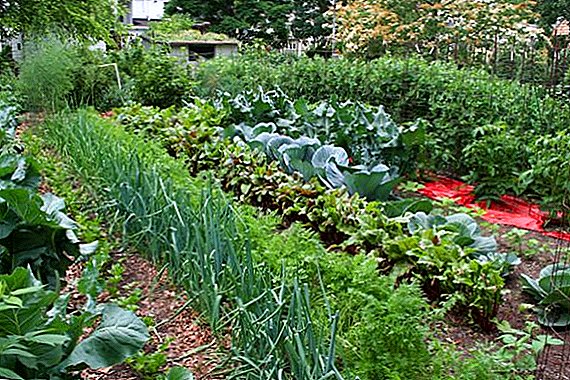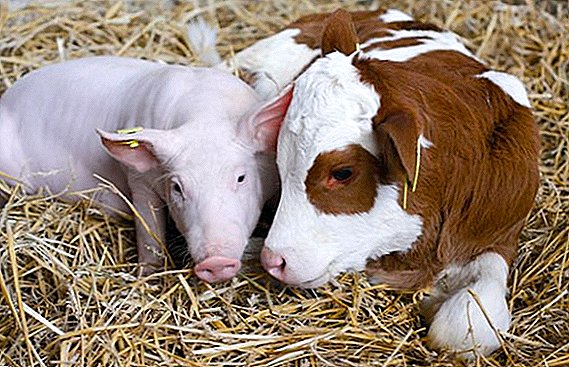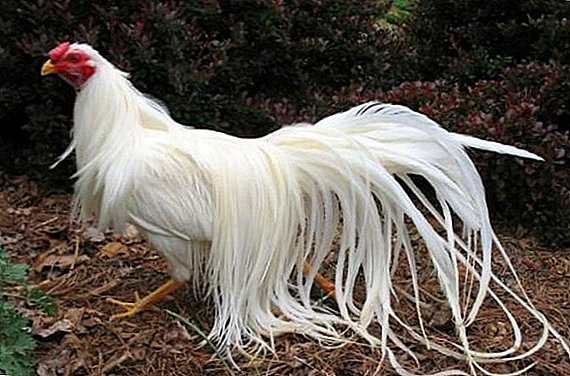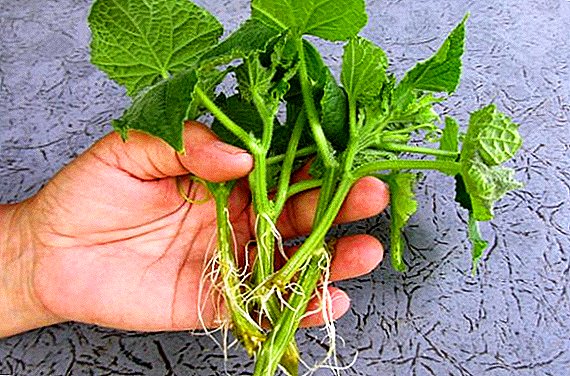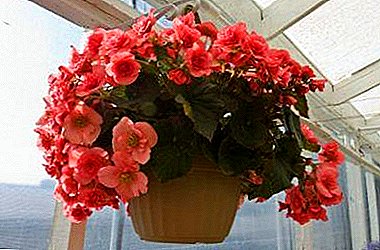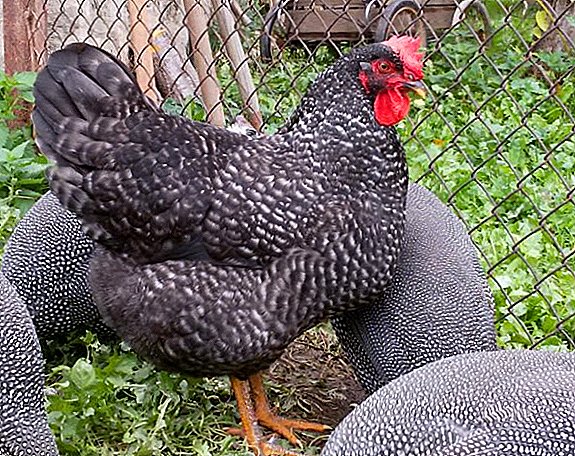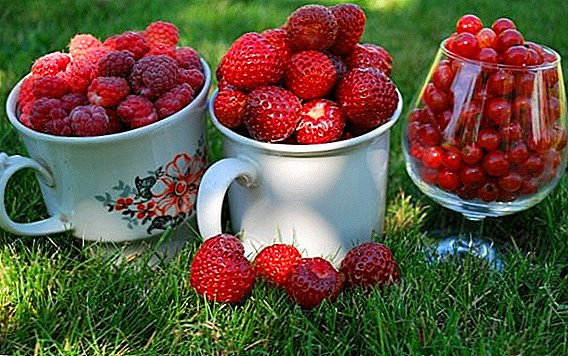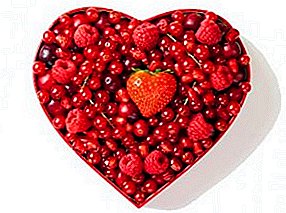 Delicious berries can be used not only in cooking, but also as medicines, and like any medicine, they have their own contraindications. Consider the beneficial properties of the most famous red berries and especially their use. We learn how to grow them and what useful substances nature gives us in the form of bright and juicy fruits.
Delicious berries can be used not only in cooking, but also as medicines, and like any medicine, they have their own contraindications. Consider the beneficial properties of the most famous red berries and especially their use. We learn how to grow them and what useful substances nature gives us in the form of bright and juicy fruits.
Strawberry
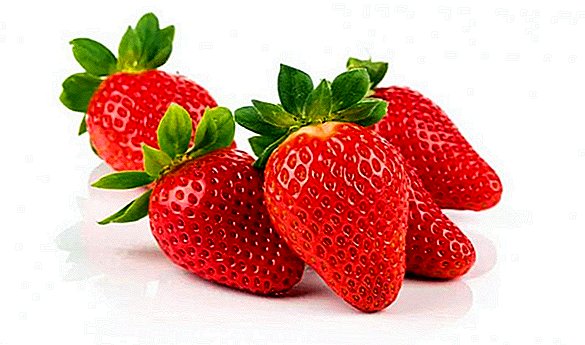 Strawberry is a perennial plant of the Rosy family, which is common in many countries of the world: in America, Europe and Central Asia. The red and juicy fruits of strawberries are very tasty and fragrant.
Strawberry is a perennial plant of the Rosy family, which is common in many countries of the world: in America, Europe and Central Asia. The red and juicy fruits of strawberries are very tasty and fragrant. 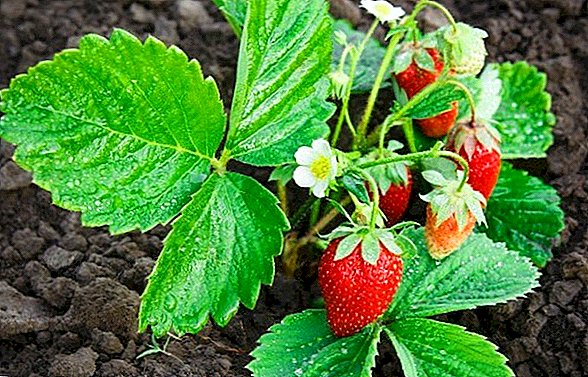 Stalks of strawberries can reach a height of 5 to 40 cm and end with large trifoliate leaves of oval shape. The root system is fibrous, well developed. Flowers of strawberry consist of five petals of round shape of white color on a short pedicle, gathered in thyroid inflorescences. Strawberries bloom from May to June, the process of ripening berries is about 3 weeks from the beginning of flowering.
Stalks of strawberries can reach a height of 5 to 40 cm and end with large trifoliate leaves of oval shape. The root system is fibrous, well developed. Flowers of strawberry consist of five petals of round shape of white color on a short pedicle, gathered in thyroid inflorescences. Strawberries bloom from May to June, the process of ripening berries is about 3 weeks from the beginning of flowering. 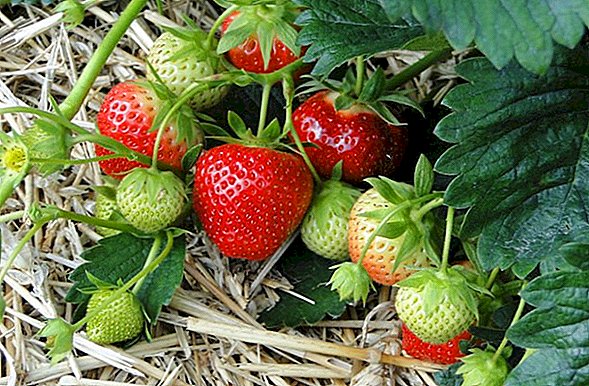 You can grow strawberries in the open field, grows well on black soil, on the south-west side.
You can grow strawberries in the open field, grows well on black soil, on the south-west side.
Tips for growing strawberries: planting rules in spring and autumn; watering; leaving in the spring, after harvesting, in the fall; transfer.
It is necessary to do weeding periodically, free from weeds. It is recommended to transplant strawberries in a new place after four years.  Strawberry is not only very tasty and fragrant, it contains a large amount nutrients for the whole human body. It contains vitamins C, A, E, group B, fruit acids, iron, calcium, manganese, phosphorus, carotene, fiber, pectin, folic acid, sugar.
Strawberry is not only very tasty and fragrant, it contains a large amount nutrients for the whole human body. It contains vitamins C, A, E, group B, fruit acids, iron, calcium, manganese, phosphorus, carotene, fiber, pectin, folic acid, sugar.
Important! Strawberry helps overcome headaches and acts like an aspirin tablet.
A handful of fragrant and delicious berries possesses diuretic and sugar lowering properties, it can be consumed by patients with diabetes. Used to raise immunity, treatment of gallstone disease, hypertension, eczema. 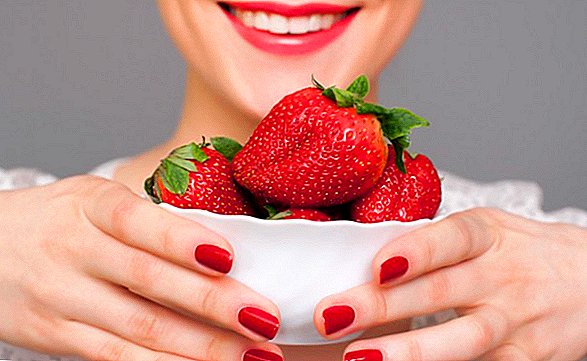 The beneficial properties of strawberries are widely used in cosmetology to improve skin health. Strawberry is an antioxidant and an excellent aphrodisiac, improves mood and helps to overcome depression. Red berry is a dietary product and improves metabolism.
The beneficial properties of strawberries are widely used in cosmetology to improve skin health. Strawberry is an antioxidant and an excellent aphrodisiac, improves mood and helps to overcome depression. Red berry is a dietary product and improves metabolism.
Familiarize yourself with recipes for preparing strawberries for the winter: jam, jam, compote, candy, tincture, frost.
Strawberries can harm people with gastritis and gastric ulcerand can also cause allergy.
Lingonberry
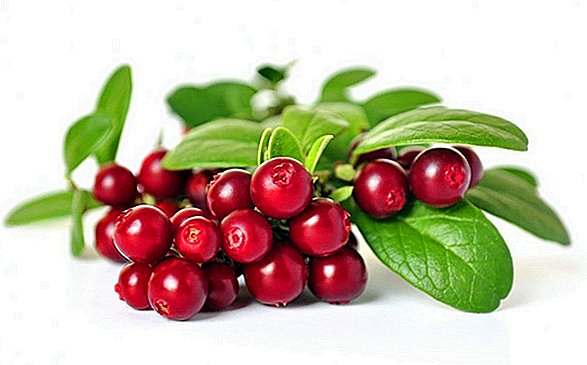 Lingonberry pleases at the beginning of autumn with red berries. It is an evergreen shrub belonging to the cowberry family. The height of the shoots is about 20 cm. Thick, opaque leaves in the shape of an ellipse up to 3 cm long. White with a pink tint flowers-bells with four petals, gathered in a brush. Fruits - shiny red berries in the shape of a ball, with a diameter of about 0.8 cm. Flowering period - from May to June.
Lingonberry pleases at the beginning of autumn with red berries. It is an evergreen shrub belonging to the cowberry family. The height of the shoots is about 20 cm. Thick, opaque leaves in the shape of an ellipse up to 3 cm long. White with a pink tint flowers-bells with four petals, gathered in a brush. Fruits - shiny red berries in the shape of a ball, with a diameter of about 0.8 cm. Flowering period - from May to June. 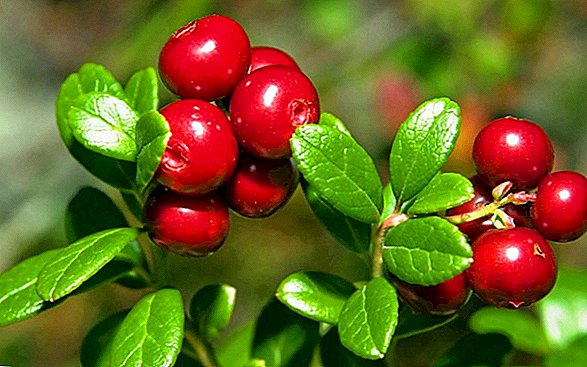 Lingonberry grows in coniferous and mixed forests, in the tundra, on peat bogs and mountain meadows. It is distributed in the north of Russia, in Siberia, in the Far East, and also in the Caucasus. Lingonberry can be grown in your own garden. For it is suitable light and smooth area with sandy, loamy or peaty soil with high acidity.
Lingonberry grows in coniferous and mixed forests, in the tundra, on peat bogs and mountain meadows. It is distributed in the north of Russia, in Siberia, in the Far East, and also in the Caucasus. Lingonberry can be grown in your own garden. For it is suitable light and smooth area with sandy, loamy or peaty soil with high acidity. 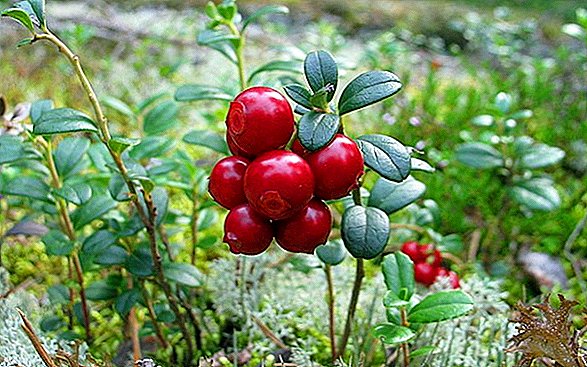 Useful properties of lingonberry known for a long time. It makes delicious fruit drinks, jams and other dishes. it remains useful even after heat treatment. Lingonberry is rich in a complex of vitamins C, E, A, group B, contains pectin, carotene, phytoncides and flavonoids. It contains a lot of fructose, macro- and microelements: calcium, potassium, manganese, iron, copper and chromium.
Useful properties of lingonberry known for a long time. It makes delicious fruit drinks, jams and other dishes. it remains useful even after heat treatment. Lingonberry is rich in a complex of vitamins C, E, A, group B, contains pectin, carotene, phytoncides and flavonoids. It contains a lot of fructose, macro- and microelements: calcium, potassium, manganese, iron, copper and chromium.
Learn how you can prepare lingonberries for the winter: with sugar, syrup, jam, as well as the benefits of lingonberries.
Lingonberry juice is an effective drug., able to improve the supporting functions of the body, the work of the digestive system, improve eyesight, get rid of skin diseases and swelling. Benzoic acid makes lingonberry a natural antiseptic. 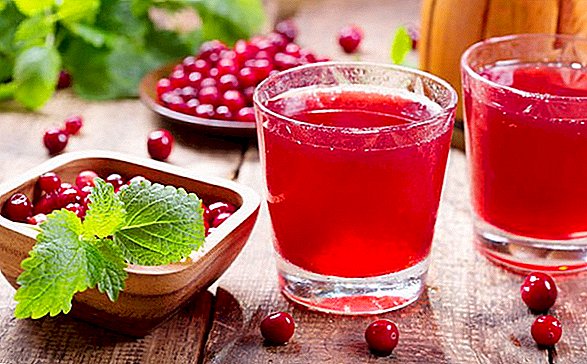 Harmful lingonberries can be for the ulcers, for those suffering from cholecystitis and kidney stones. People with low blood pressure should be careful to use lingonberries, as it lowers pressure.
Harmful lingonberries can be for the ulcers, for those suffering from cholecystitis and kidney stones. People with low blood pressure should be careful to use lingonberries, as it lowers pressure.
Raspberries
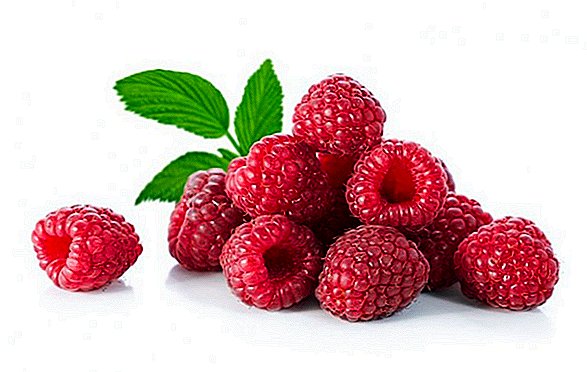 Sweet and fragrant raspberry is a semi-shrub with upright, prickly stems with a height of more than 1.5 m, a representative of the Pink family. The complex, oval leaves are covered with small hairs. Raspberry white flowers with a greenish tinge, up to 1 cm in diameter, are collected in clusters of brush.
Sweet and fragrant raspberry is a semi-shrub with upright, prickly stems with a height of more than 1.5 m, a representative of the Pink family. The complex, oval leaves are covered with small hairs. Raspberry white flowers with a greenish tinge, up to 1 cm in diameter, are collected in clusters of brush.
Fruits are spherical, consist of small stones, covered with hairs, which have grown together into a conical receptacle. The color of the fruit is red, but there is a variety of yellow. Raspberries are very tasty and healthy berries. The period of flowering of raspberries begins in May and ends in June, ripe berries appear in early summer and until August. 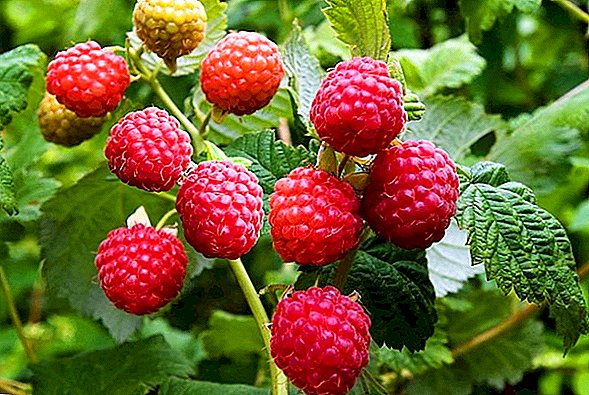 Raspberry grows between shrubs in the forests of Ukraine, Belarus, Russia, it can be found in the Caucasus Mountains, Central Asia and the Carpathians. In addition to wild raspberries, there are many varieties of useful berries that can be grown in the garden.
Raspberry grows between shrubs in the forests of Ukraine, Belarus, Russia, it can be found in the Caucasus Mountains, Central Asia and the Carpathians. In addition to wild raspberries, there are many varieties of useful berries that can be grown in the garden.
Familiarize yourself with the basics of growing raspberries: planting in spring and autumn, pruning, transplanting, preparing for winter.
Raspberries have a two-year development cycle, it grows well in well-lit places, protected from strong wind, with a soil that is neutral in acidity. It can be grown in rows or individual bushes. 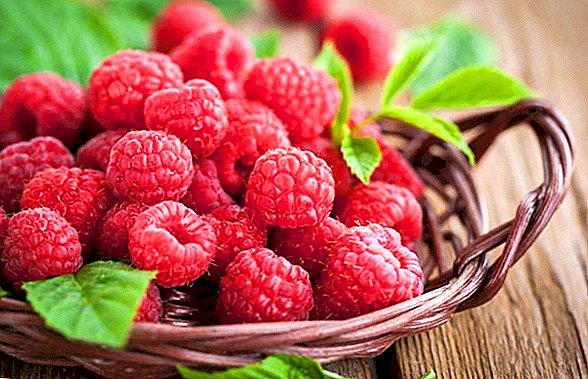 Tasty and fragrant raspberry jam for many years used for treating colds as a febrifuge and diaphoretic.
Tasty and fragrant raspberry jam for many years used for treating colds as a febrifuge and diaphoretic.
Read also about the beneficial properties and methods of harvesting raspberries: jam, brandy, wine.
The raspberry contains the elements: iron, potassium, calcium, phosphorus, magnesium, organic acids. Juicy berries are rich in vitamins C, A, B, PP, they contain fructose and glucose, pectin. Broths and raspberry syrups strengthen the immune system and reduce pressure, beneficially affect the work of the intestine. In medicine, not only berries are used, but leaves and roots. Raspberry has antiseptic properties. 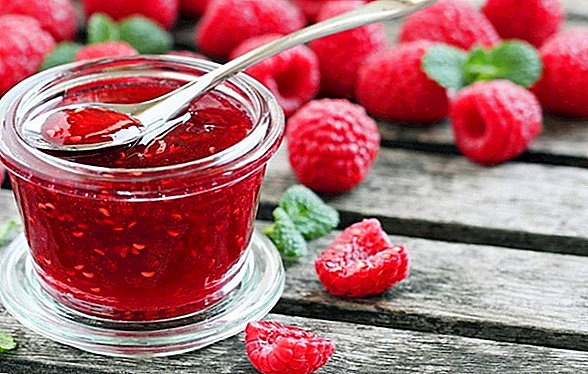 Essential oils that raspberries contain can cause allergic reactions. Also, fresh raspberry juice is contraindicated for people suffering from gastritis or gastric ulcer, kidney disease. Raspberry is contraindicated in patients with bronchial asthma.
Essential oils that raspberries contain can cause allergic reactions. Also, fresh raspberry juice is contraindicated for people suffering from gastritis or gastric ulcer, kidney disease. Raspberry is contraindicated in patients with bronchial asthma.
Dogwood
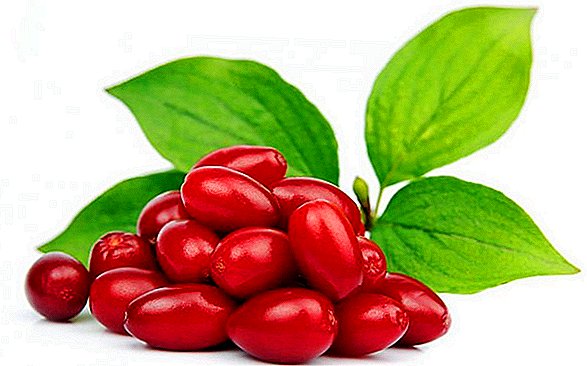 Cornel is a small tree or shrub from the Caucasus. The bright fruits of the cornel have excellent taste and beneficial properties, contain a large number of active substances.
Cornel is a small tree or shrub from the Caucasus. The bright fruits of the cornel have excellent taste and beneficial properties, contain a large number of active substances.
The height of the cornel can reach 3-6 m, the branches are covered with grayish bark, arranged horizontally. The length of the oval leaves is from 3 to 8 cm. Small golden flowers consist of four petals and are gathered into an inflorescence umbrella. Petals with sharp ends. Juicy fruit can be oval, pear-shaped or spherical. Inside the fruit is quite a large long bone. Berries ripen in late summer - early September. 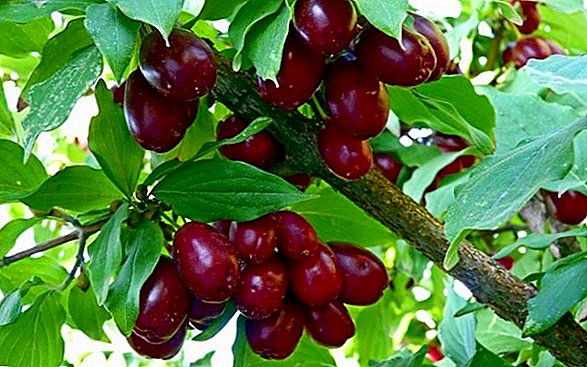 Dogwood is found in the wild mainly in the Caucasus. It can be found in the gardens as a cultivated plant in Europe and Central Asia, in Ukraine, Moldova, Russia.
Dogwood is found in the wild mainly in the Caucasus. It can be found in the gardens as a cultivated plant in Europe and Central Asia, in Ukraine, Moldova, Russia.
Cornel loves light soils with good air access, it is frost-resistant and drought-resistant. Fruit varieties multiply vegetatively or by seed.
The loquate root system requires watering until the seedling takes root. This plant is a long-liver and can grow over a hundred years. 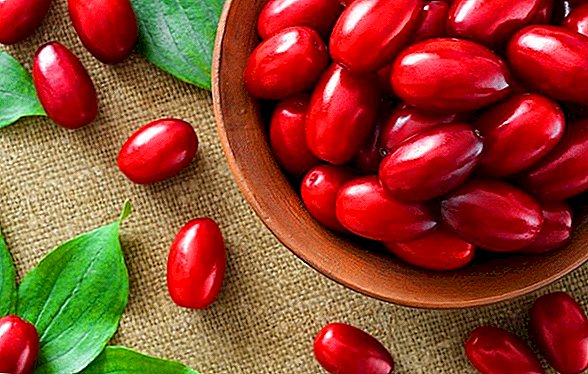 Dogwood fruits have long been used in food, they have a pleasant aroma, tart taste, moderately sweet with a little sourness. From fruits are cooked inkusoty compotes, jam, jam, wine, used as a seasoning for various dishes. The bones are used as an alternative to coffee, to make an aromatic beverage, the leaves are brewed as tea.
Dogwood fruits have long been used in food, they have a pleasant aroma, tart taste, moderately sweet with a little sourness. From fruits are cooked inkusoty compotes, jam, jam, wine, used as a seasoning for various dishes. The bones are used as an alternative to coffee, to make an aromatic beverage, the leaves are brewed as tea. 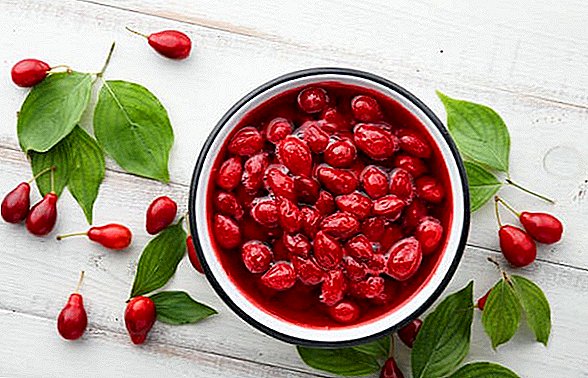 Cornel has healing properties: normalizes blood pressure, strengthens and tones. The content of vitamin C in it is much more than in lemon. Contains pectin and phytoncides, organic acids, macronutrients (magnesium, calcium, potassium). It has a beneficial effect on the digestive tract and has an anti-inflammatory effect.
Cornel has healing properties: normalizes blood pressure, strengthens and tones. The content of vitamin C in it is much more than in lemon. Contains pectin and phytoncides, organic acids, macronutrients (magnesium, calcium, potassium). It has a beneficial effect on the digestive tract and has an anti-inflammatory effect.
Check out the selection of methods and recipes billet dogwood for the winter.
Dogwood contraindicated with acidity and insomniaIt is also necessary with caution to take pregnant women, may cause allergies.
Viburnum
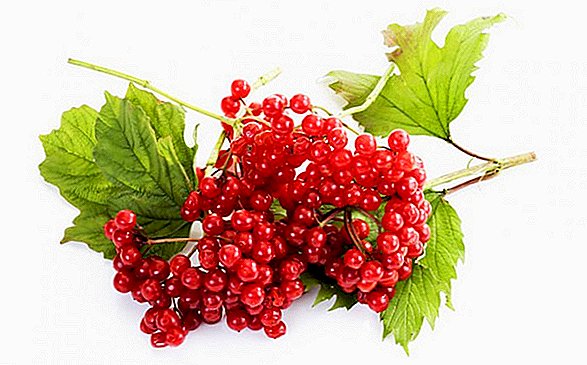 Kalina many centuries adorns the gardens and is used as a green doctor. This tree or shrub can grow to a few meters. On round shoots placed leaves of three to five blades, with sharp ends in the form of cloves. White flowers are gathered in an inflorescence umbrella on the ends of young shoots. The fruit is in the shape of a ball, bright red. The diameter of the stone - 0.5-1 cm, inside is a large round bone. The flowering period begins in May and continues in June. Fruits ripen in the fall.
Kalina many centuries adorns the gardens and is used as a green doctor. This tree or shrub can grow to a few meters. On round shoots placed leaves of three to five blades, with sharp ends in the form of cloves. White flowers are gathered in an inflorescence umbrella on the ends of young shoots. The fruit is in the shape of a ball, bright red. The diameter of the stone - 0.5-1 cm, inside is a large round bone. The flowering period begins in May and continues in June. Fruits ripen in the fall. 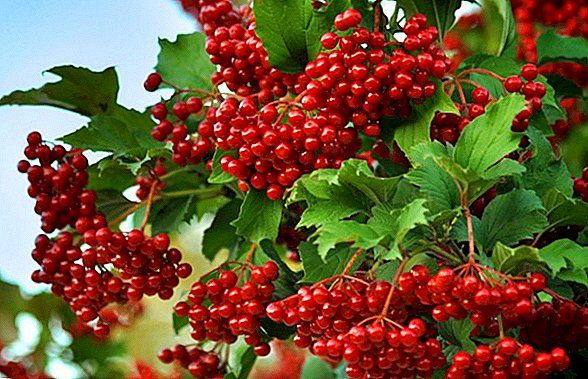 Kalina is found wild in Europe and Asia, it grows well in a temperate climate zone. Very unpretentious and frost-resistant, also tolerates drought. You can grow viburnum in sunny or slightly shaded places.
Kalina is found wild in Europe and Asia, it grows well in a temperate climate zone. Very unpretentious and frost-resistant, also tolerates drought. You can grow viburnum in sunny or slightly shaded places.
Learn more about the cultivation of viburnum: popular species, reproduction, pests and diseases.
Viburnum bushes are planted in the garden at a distance of 2-3 m from each other. Kalina is beautiful ornamental plant in all seasons. 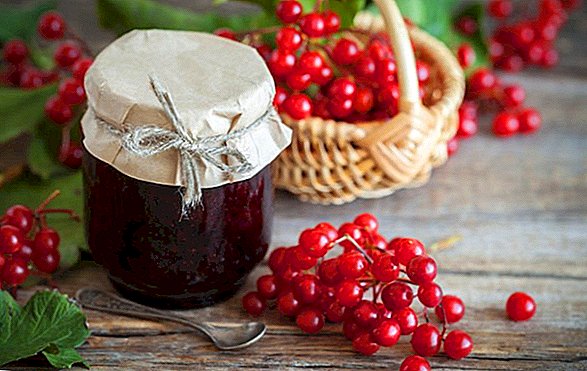 Red berries of viburnum are used as a medicine. Vitamin C helps to overcome colds, viruses. Kalina is able to lower blood pressure, treats cough. The berries contain vitamins E, A, P, K, organic acids, pectin, phytoncides, a number of macro- and microelements (iron, phosphorus, molybdenum, potassium, etc.).
Red berries of viburnum are used as a medicine. Vitamin C helps to overcome colds, viruses. Kalina is able to lower blood pressure, treats cough. The berries contain vitamins E, A, P, K, organic acids, pectin, phytoncides, a number of macro- and microelements (iron, phosphorus, molybdenum, potassium, etc.). 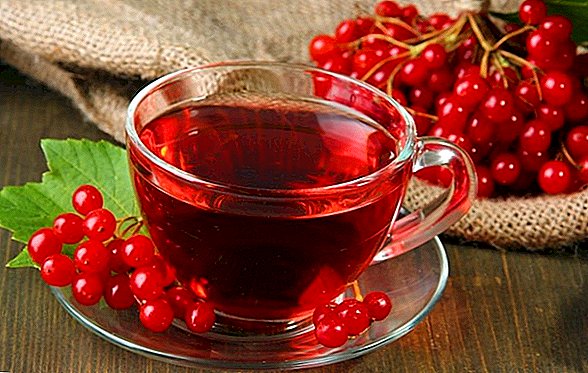 The sour taste of viburnum is due to organic acids. In terms of healing qualities, it has no equal, it improves the functioning of the liver, heart, gastrointestinal tract, has diuretic and antipyretic properties.
The sour taste of viburnum is due to organic acids. In terms of healing qualities, it has no equal, it improves the functioning of the liver, heart, gastrointestinal tract, has diuretic and antipyretic properties.
Read also about the benefits of viburnum red for women's health, viburnum bark for the human body, as well as about the harvesting of viburnum for the winter: viburnum juice, viburnum with sugar.
Do not eat Kalina hypotensive, people with high acidity, kidney disease, pregnant women.
Barberry
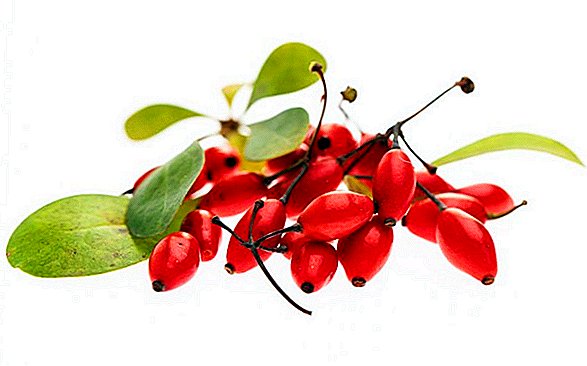 Barberry - ornamental shrub, branched, with prickles, more than 2 m high. Leaves in the form of an ellipse up to 4 cm long, with fine teeth. Yellow flowers with six round petals are collected in a brush. The diameter of the flowers is about 0.7 cm. The fruits are oblong, red, more than 1 cm long, sour to the taste. The barberry blossoms from the middle of spring and to the end of May. Berries ripen in September-October.
Barberry - ornamental shrub, branched, with prickles, more than 2 m high. Leaves in the form of an ellipse up to 4 cm long, with fine teeth. Yellow flowers with six round petals are collected in a brush. The diameter of the flowers is about 0.7 cm. The fruits are oblong, red, more than 1 cm long, sour to the taste. The barberry blossoms from the middle of spring and to the end of May. Berries ripen in September-October.  Barberry is found in nature in the forest-steppe zone in European and Asian countries in the Caucasus. This shrub has a beautiful crown shape, looks very attractive in the fall, when the leaves turn red, decorate many gardens and widely used by landscape designers.
Barberry is found in nature in the forest-steppe zone in European and Asian countries in the Caucasus. This shrub has a beautiful crown shape, looks very attractive in the fall, when the leaves turn red, decorate many gardens and widely used by landscape designers.
Check out the varieties of barberries: Thunberg (cultivation and varieties), Ottawa Superba.
Grow barberry preferably in well-lit places. It reproduces by seeds or cuttings and shoots. Planting is best done in the fall.  Barberry is widely used in cooking, the fruit is dried and added as a seasoning to many oriental dishes. Fruits and leaves contain large amounts of alkaloids, vitamin K, fructose, glucose, organic acids and pectins. Berries make delicious juices and jams, fragrant sauces.
Barberry is widely used in cooking, the fruit is dried and added as a seasoning to many oriental dishes. Fruits and leaves contain large amounts of alkaloids, vitamin K, fructose, glucose, organic acids and pectins. Berries make delicious juices and jams, fragrant sauces. 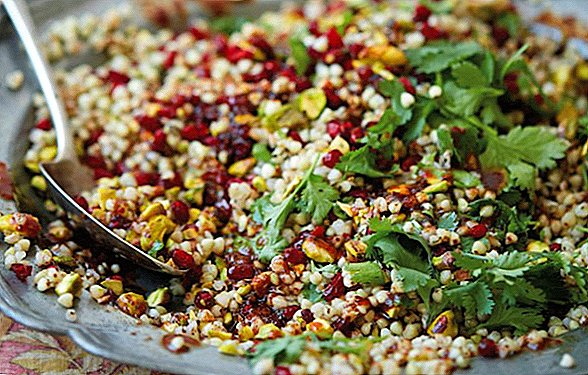 Barberry is used in traditional medicine, It is indicated for hypertensive patients, has antibacterial properties., improves the supporting functions of the body due to the content of vitamin C, treats liver diseases, diabetes, has a choleretic effect.
Barberry is used in traditional medicine, It is indicated for hypertensive patients, has antibacterial properties., improves the supporting functions of the body due to the content of vitamin C, treats liver diseases, diabetes, has a choleretic effect.
Learn more about the composition, properties and use of barberry.
Contraindicated barberry hypotonicis, people with high acidity and blood clotting, pregnant women and during menopause. Long-term use can lead to constipation.
Currant
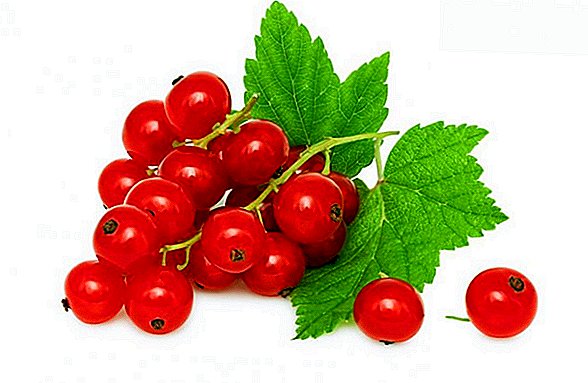 Red currant is a perennial shrub with a height of 1-2 m. It belongs to the Gooseberry family. Serrated leaves with 3-5 lobes. The flowers are small yellow in brush clusters. The berries are bright, red with a sour taste.
Red currant is a perennial shrub with a height of 1-2 m. It belongs to the Gooseberry family. Serrated leaves with 3-5 lobes. The flowers are small yellow in brush clusters. The berries are bright, red with a sour taste. 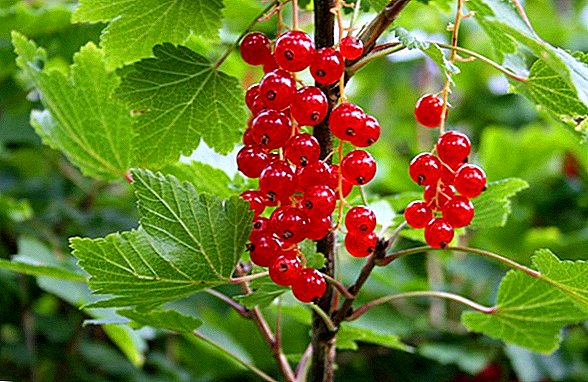 Red currant is spread throughout Eurasia near water sources and on forest edges. Grow currants as an ornamental shrub and for obtaining useful berries. For it suitable sunny places on the south side with loamy soil or black soil.
Red currant is spread throughout Eurasia near water sources and on forest edges. Grow currants as an ornamental shrub and for obtaining useful berries. For it suitable sunny places on the south side with loamy soil or black soil.  Currant - a storehouse of vitamins and nutrients. It contains especially a lot of vitamin Cand also vitamins of group B, vitamins A, E, K. Sour berries are rich in potassium, phosphorus and calcium, as well as iron, selenium and zinc. Used in cooking for making various desserts.
Currant - a storehouse of vitamins and nutrients. It contains especially a lot of vitamin Cand also vitamins of group B, vitamins A, E, K. Sour berries are rich in potassium, phosphorus and calcium, as well as iron, selenium and zinc. Used in cooking for making various desserts.  Red currant has anti-inflammatory and antipyretic effects, improves appetite and quenches thirst. In folk medicine used berries and currant leaves.
Red currant has anti-inflammatory and antipyretic effects, improves appetite and quenches thirst. In folk medicine used berries and currant leaves.
Treat yourself and your relatives with delicious redcurrant preparations: jam, jam, compote.
Red Currant Juice contraindicated with gastritis, ulcers, pancreatitis and cholecystitis.
Cranberry
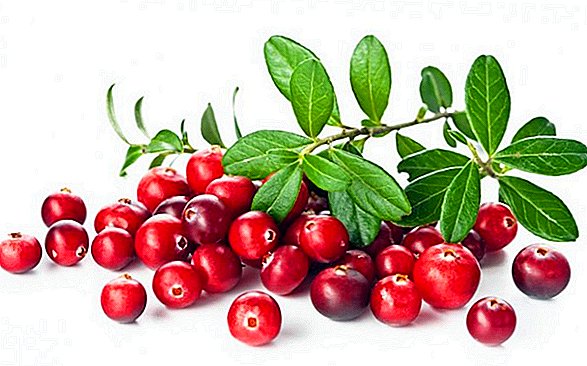 Cranberries are an evergreen creeping plant belonging to the heather family. Stems are flexible and thin. The leaves are small oblong in shape, up to 1.5 cm long, dark green in color. Cranberries are blooming at the end of spring - at the beginning of summer with pink flowers on a long stalk. Fruits are round-shaped, bright red in color and can reach 1.5 cm in diameter. The taste of cranberries is sour.
Cranberries are an evergreen creeping plant belonging to the heather family. Stems are flexible and thin. The leaves are small oblong in shape, up to 1.5 cm long, dark green in color. Cranberries are blooming at the end of spring - at the beginning of summer with pink flowers on a long stalk. Fruits are round-shaped, bright red in color and can reach 1.5 cm in diameter. The taste of cranberries is sour. 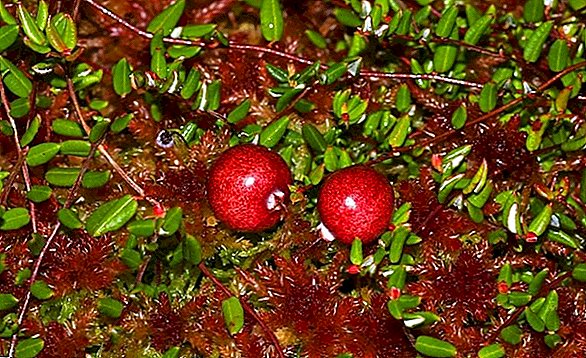 Cranberries grow in swampy areas, in moist coniferous forests, on the shores of lakes in the northern region. This useful berry is grown commercially on special plantations in the USA, Poland, Canada, and Russia. Cranberries are very light-requiring, frost-resistant and not demanding on the soil. It can be grown on the plot, vegetatively propagated. The place is suitable well lit and wet, the soil should be peat or a substrate with sphagnum moss and needles.
Cranberries grow in swampy areas, in moist coniferous forests, on the shores of lakes in the northern region. This useful berry is grown commercially on special plantations in the USA, Poland, Canada, and Russia. Cranberries are very light-requiring, frost-resistant and not demanding on the soil. It can be grown on the plot, vegetatively propagated. The place is suitable well lit and wet, the soil should be peat or a substrate with sphagnum moss and needles. 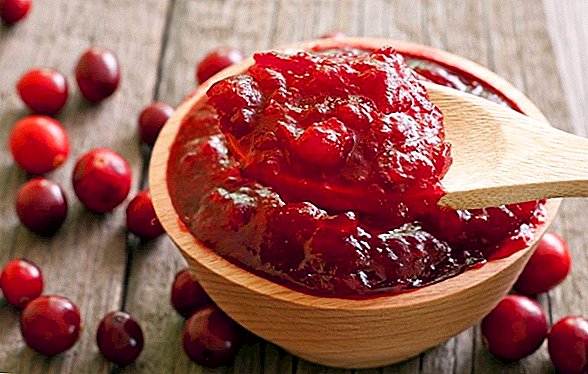 The value of cranberries is rich in vitamin composition, it is natural antioxidant. It contains the main micro and macronutrients, vitamins of group B, C, A, K. Cranberry helps diabetic patients, hypertensive patients, people with kidney diseases and the excretory system, with rheumatism and skin diseases.
The value of cranberries is rich in vitamin composition, it is natural antioxidant. It contains the main micro and macronutrients, vitamins of group B, C, A, K. Cranberry helps diabetic patients, hypertensive patients, people with kidney diseases and the excretory system, with rheumatism and skin diseases.
Learn more about the medicinal properties and use of cranberries (for women's health), as well as get acquainted with the recipes for cranberry harvesting: freezing, tincture.
Cranberries are contraindicated in gastritis and ulcers with high acidity, as well as in liver diseases.
Did you know? Fresh cranberries can be stored until the next harvest in wooden barrels of water.
Rosehip
 Rosehip - a member of the family Pink, a bush with straight stems covered with spikes. Leaves are pinnate with 5 leaves from 4 to 9 cm long. Single flowers of light pink color about 5 cm in diameter. Fruits are oval or spherical, juicy, smooth, with a diameter up to 1.5 cm. Ripen in September.
Rosehip - a member of the family Pink, a bush with straight stems covered with spikes. Leaves are pinnate with 5 leaves from 4 to 9 cm long. Single flowers of light pink color about 5 cm in diameter. Fruits are oval or spherical, juicy, smooth, with a diameter up to 1.5 cm. Ripen in September. 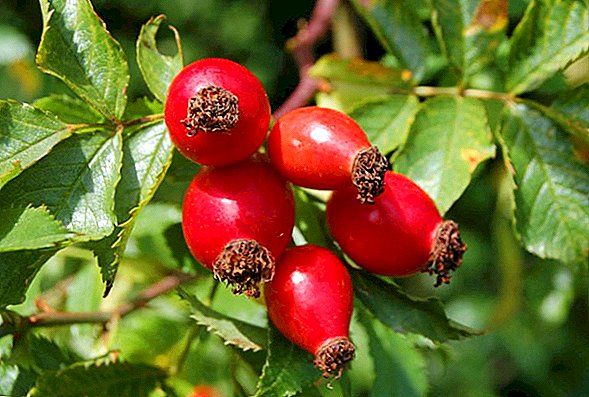 Rosehip grows in a temperate and subtropical climate, widely distributed in Central Asia, Ukraine, Russia, Belarus, Moldova. It is possible to grow wild rose in the garden, it is a relative of a rose and possesses decorative qualities. Can be used as a green hedge. The easiest way to breed wild rose - cuttings. This unpretentious plant grows well in fertile soil with moderate moisture in bright places.
Rosehip grows in a temperate and subtropical climate, widely distributed in Central Asia, Ukraine, Russia, Belarus, Moldova. It is possible to grow wild rose in the garden, it is a relative of a rose and possesses decorative qualities. Can be used as a green hedge. The easiest way to breed wild rose - cuttings. This unpretentious plant grows well in fertile soil with moderate moisture in bright places. 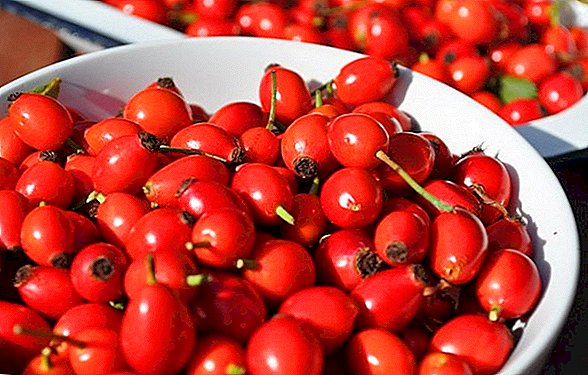 Rosehip is especially rich in vitamin C, as well as vitamins A, K, B2, E, keratin. He has bactericidal property and is a natural antioxidant. Rose hip tea helps to cure colds, urogenital diseases, cholelithiasis faster.
Rosehip is especially rich in vitamin C, as well as vitamins A, K, B2, E, keratin. He has bactericidal property and is a natural antioxidant. Rose hip tea helps to cure colds, urogenital diseases, cholelithiasis faster.
Drying rosehips is the oldest method of canning berries for long-term storage. In this form, their skin is petrified, the constituent elements in the process of moisture loss are strongly compacted, but do not lose their healing qualities.
As a medicine, not only fruits are used, but also flowers and roots. Rosehip helps with skin diseases, arthritis, anemia.  A high content of vitamin C can raise the acidity, so the ulcers and people suffering from gastritis, it is necessary to use rose hips with caution. Strong infusions can damage tooth enamel, prolonged use in large quantities disrupts the liver and other internal organs.
A high content of vitamin C can raise the acidity, so the ulcers and people suffering from gastritis, it is necessary to use rose hips with caution. Strong infusions can damage tooth enamel, prolonged use in large quantities disrupts the liver and other internal organs.
Hawthorn
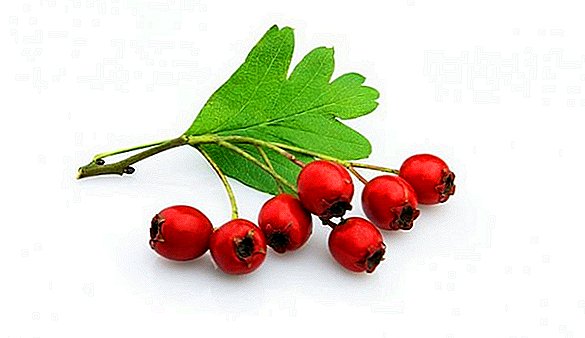 Hawthorn is a thorny shrub or tree of the Pink family. The next leaves with cloves are arranged in a spiral. Blooms hawthorn inflorescences of the thyroid form. White flowers with five petals. Fruits - from orange to burgundy, spherical or elongated, solid with a sweetish taste. In diameter, the fruit can reach from 0.5 to 4 cm. It ripens in late August - early September.
Hawthorn is a thorny shrub or tree of the Pink family. The next leaves with cloves are arranged in a spiral. Blooms hawthorn inflorescences of the thyroid form. White flowers with five petals. Fruits - from orange to burgundy, spherical or elongated, solid with a sweetish taste. In diameter, the fruit can reach from 0.5 to 4 cm. It ripens in late August - early September. 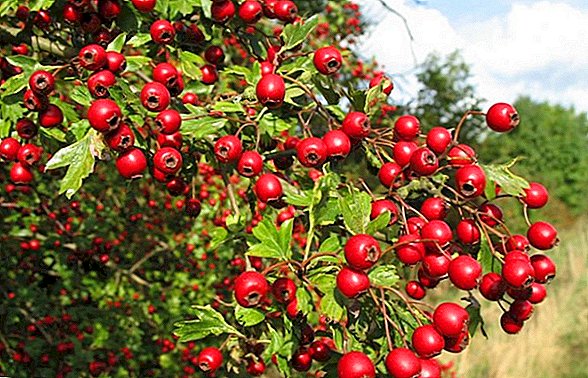 Hawthorn grows on forest edges and river banks in Eurasia, North America. It is not whimsical, resistant to drought and frost. It develops well on moderately moist fertile soils in sunny places.
Hawthorn grows on forest edges and river banks in Eurasia, North America. It is not whimsical, resistant to drought and frost. It develops well on moderately moist fertile soils in sunny places.
Hawthorn is ideal for hedges, often used as an ornamental plant.
Openwork leaves, white flowers and red fruits look very beautiful from spring to late autumn. 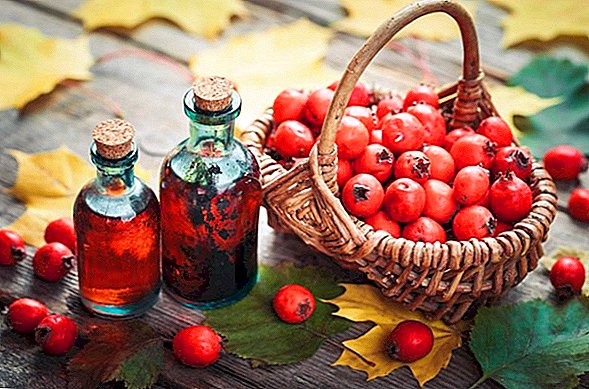 Hawthorn has healing properties. used in medicine flowers, fruits and leaves. The fruits have antioxidant properties and are used to treat heart disease, to cleanse the blood vessels and improve blood circulation. They contain ascorbic acid, vitamin K, flavonoids and ursolic acid, which expands blood vessels. Hawthorn has a beneficial effect on the nervous system, relieves stress and calms.
Hawthorn has healing properties. used in medicine flowers, fruits and leaves. The fruits have antioxidant properties and are used to treat heart disease, to cleanse the blood vessels and improve blood circulation. They contain ascorbic acid, vitamin K, flavonoids and ursolic acid, which expands blood vessels. Hawthorn has a beneficial effect on the nervous system, relieves stress and calms.
Read also about picking berries and hawthorn harvesting for the winter (jam).
Hawthorn can do harm if you eat it on an empty stomach or drink cold water, cramps and intestinal colic occur. Prolonged use of hawthorn in large doses can slow the heart rate and inhibit the nervous system.
Rowan
 Another shrub or tree, a representative of the family Pink - Rowan. Thick branches of rowan crowned with long and narrow leaves with sharp cloves. Blooms with white flowers, gathered in inflorescences umbrella. The flowering period begins in late May and continues in June. Orange fruit the size of a pea, ball-shaped form with a bitter and tart taste. Rowan tree ripens in September, after frosts it becomes sweet, astringency disappears.
Another shrub or tree, a representative of the family Pink - Rowan. Thick branches of rowan crowned with long and narrow leaves with sharp cloves. Blooms with white flowers, gathered in inflorescences umbrella. The flowering period begins in late May and continues in June. Orange fruit the size of a pea, ball-shaped form with a bitter and tart taste. Rowan tree ripens in September, after frosts it becomes sweet, astringency disappears. 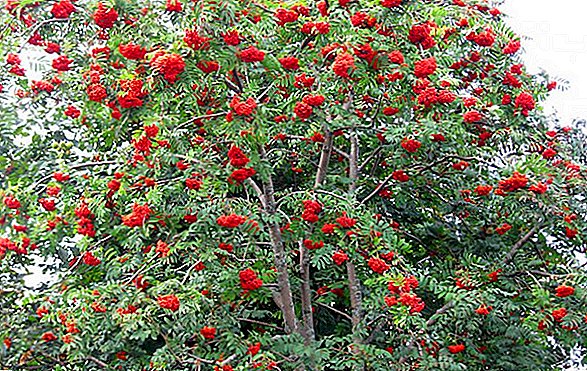 Many species of mountain ash are common in temperate climates in Europe, Asia and North America. Rowan bunches look beautiful in autumn and winter. It decorated many estates of the Slavs, in ancient times they believed that mountain ash protects housing from evil forces. Growing mountain ash is not difficult, it grows well on fertile land in a well-lit area. You can multiply from ripe berries, you must get the seeds from the pulp and sow in the fall in the soil.
Many species of mountain ash are common in temperate climates in Europe, Asia and North America. Rowan bunches look beautiful in autumn and winter. It decorated many estates of the Slavs, in ancient times they believed that mountain ash protects housing from evil forces. Growing mountain ash is not difficult, it grows well on fertile land in a well-lit area. You can multiply from ripe berries, you must get the seeds from the pulp and sow in the fall in the soil. 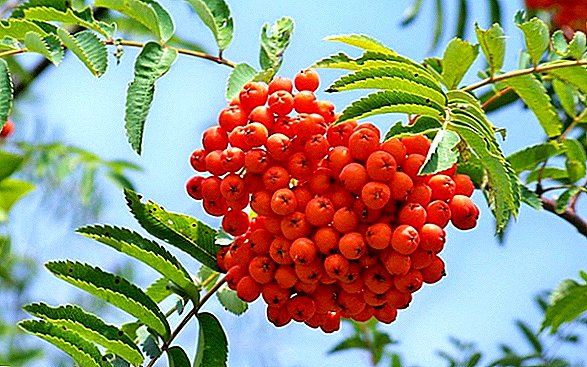 Rowan berries are used to make jam, marshmallow, jelly, alcoholic and non-alcoholic beverages. The composition of the fruits of mountain ash is rich in a number of vitamins (C, A, E, B, PP), organic acids, carotene, flavonoids and tannins.
Rowan berries are used to make jam, marshmallow, jelly, alcoholic and non-alcoholic beverages. The composition of the fruits of mountain ash is rich in a number of vitamins (C, A, E, B, PP), organic acids, carotene, flavonoids and tannins. 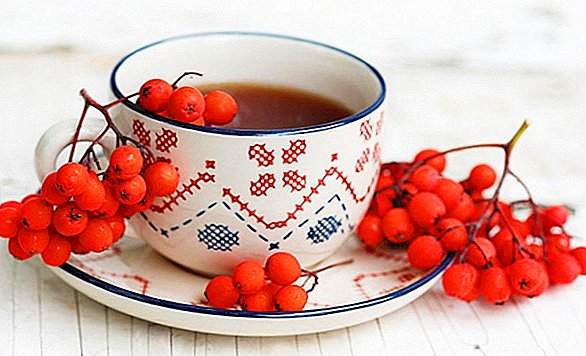 Berries are used in traditional medicine. Rowan helps to improve metabolism and digestion, has diuretic and choleretic properties, can have an antibacterial effect and improves the supporting functions of the body as a whole.
Berries are used in traditional medicine. Rowan helps to improve metabolism and digestion, has diuretic and choleretic properties, can have an antibacterial effect and improves the supporting functions of the body as a whole.
Learn more about the beneficial properties and use of rowan red.
Rowan is contraindicated for people with high acidity, heart disease and with increased blood clotting.
Irga
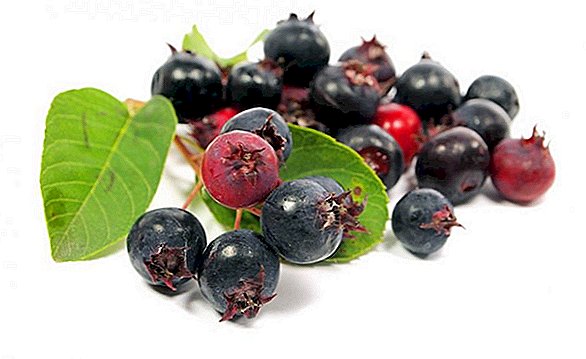 Not everyone is familiar with Irga, another member of the Pink family. It is an ornamental shrub or low tree up to 2.5 m high. Simple leaves of oval shape with cloves along the edge. Blooms profusely with white flowers, gathered in lush brush. Fruits are apple-shaped with a diameter of 1 cm, color from red-violet to dark blue. Irga ripens in late July and August, the fruits are fleshy and sweet.
Not everyone is familiar with Irga, another member of the Pink family. It is an ornamental shrub or low tree up to 2.5 m high. Simple leaves of oval shape with cloves along the edge. Blooms profusely with white flowers, gathered in lush brush. Fruits are apple-shaped with a diameter of 1 cm, color from red-violet to dark blue. Irga ripens in late July and August, the fruits are fleshy and sweet. 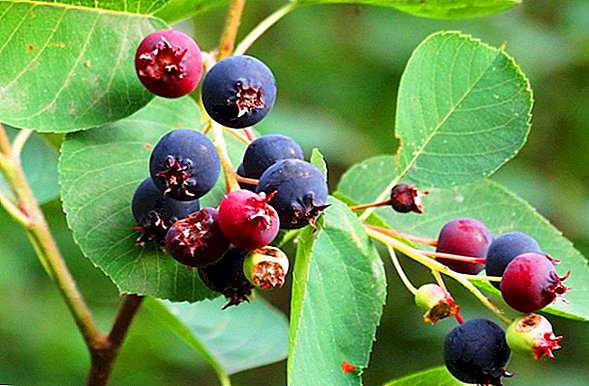 Irga grows in temperate climates in Europe, North Africa, North America, and Japan. Shrub easily adapts to new conditions, it can be found on the rocky slopes in the Caucasus and the Crimea.
Irga grows in temperate climates in Europe, North Africa, North America, and Japan. Shrub easily adapts to new conditions, it can be found on the rocky slopes in the Caucasus and the Crimea.
Familiarize yourself with the Irgi species: Canadian, alder, Lamarck.
Thanks to unpretentiousness, winter hardiness, good decorative and fruitful properties, many gardeners grow irgu on their plots. The shrub grows well and bears fruit in bright areas, it is not demanding to the soil. Propagated by dividing the bush, cuttings and seeds. 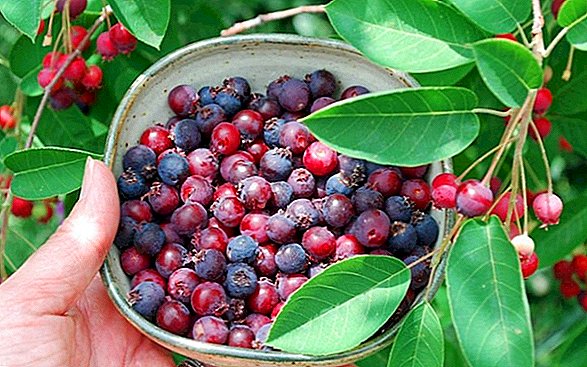 From the berries make the perfect wine, jams, marshmallow. Irga is also used in medicine as a source of vitamins and other beneficial substances. It is particularly rich in vitamin PP, which has a beneficial effect on the state of the blood vessels and the work of the heart. Fruits improve digestion, are used for hypovitaminosis.
From the berries make the perfect wine, jams, marshmallow. Irga is also used in medicine as a source of vitamins and other beneficial substances. It is particularly rich in vitamin PP, which has a beneficial effect on the state of the blood vessels and the work of the heart. Fruits improve digestion, are used for hypovitaminosis.
Application irgi in cooking wide. Dried berry resembles raisins and is used as a filling for pies, cakes and pastries. Ground shredded irgu is used to make cupcakes, casseroles, pancakes, and fritters. For desserts and main dishes, with the addition of berries irgi prepare sauces.
Irregular damage can also be caused by hypotonia in case of individual intolerance. Berries have a calming effect, it must be considered, especially when driving a car, and do not abuse the sweet dessert.
Lemongrass
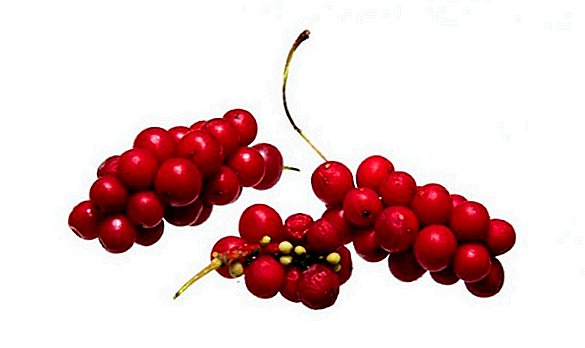 Lemongrass is a perennial climbing plant of the Magnolia family. Lianoobraznye branches can reach lengths of more than 10 m with a thickness of 1-2 cm. Simple leaves have an ovate shape, rather large. Lemongrass blooms with white or pink flowers, collected in a brush. The flowering period begins in late spring and continues in June. The fruits of lemongrass bright red color, spherical, the size of a red currant. The taste of the fruit is sour with bitterness, and the aroma is like that of a lemon. Fruits ripen in early autumn. Lemongrass is quite a fruitful crop, but bears fruit after a year.
Lemongrass is a perennial climbing plant of the Magnolia family. Lianoobraznye branches can reach lengths of more than 10 m with a thickness of 1-2 cm. Simple leaves have an ovate shape, rather large. Lemongrass blooms with white or pink flowers, collected in a brush. The flowering period begins in late spring and continues in June. The fruits of lemongrass bright red color, spherical, the size of a red currant. The taste of the fruit is sour with bitterness, and the aroma is like that of a lemon. Fruits ripen in early autumn. Lemongrass is quite a fruitful crop, but bears fruit after a year. 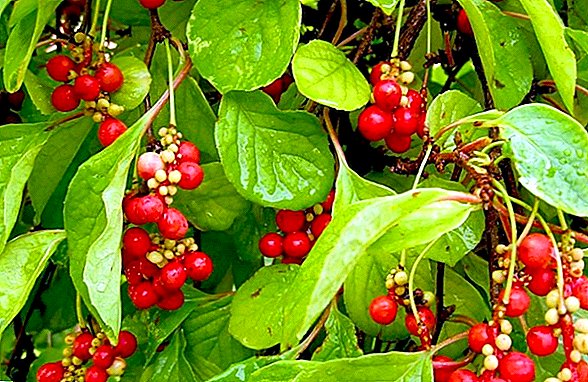 In the wild, lemongrass is found in China, Japan, the Far East, the Kuril Islands. Gardeners grow lemongrass as an ornamental and fruit plant. It is recommended to grow on a two-meter trellis in a sunny and sheltered place. The plant develops well in light and well-drained soil. It is easiest to propagate lemongrass with cuttings and layering.
In the wild, lemongrass is found in China, Japan, the Far East, the Kuril Islands. Gardeners grow lemongrass as an ornamental and fruit plant. It is recommended to grow on a two-meter trellis in a sunny and sheltered place. The plant develops well in light and well-drained soil. It is easiest to propagate lemongrass with cuttings and layering. 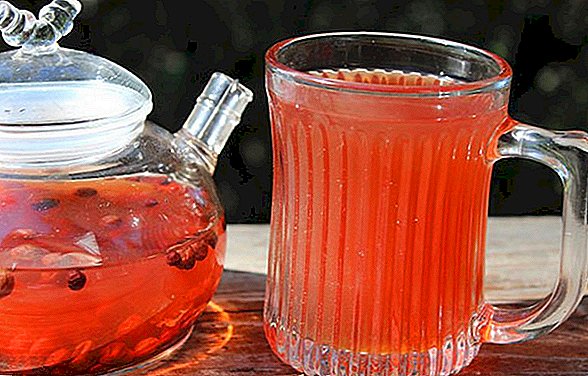 Lemongrass is rich in vitamins E and C, it contains essential oils, organic acids. Beneficial substances contained in fruits improve the nervous and cardiovascular systems, liver. Drinks of lemongrass have a tonic effect.
Lemongrass is rich in vitamins E and C, it contains essential oils, organic acids. Beneficial substances contained in fruits improve the nervous and cardiovascular systems, liver. Drinks of lemongrass have a tonic effect.
Learn more about the composition and beneficial properties of Chinese Schizandra.
Lemongrass is contraindicated in people suffering from insomnia, increased acidity of the stomach and hypertensive patients.
Cloudberry
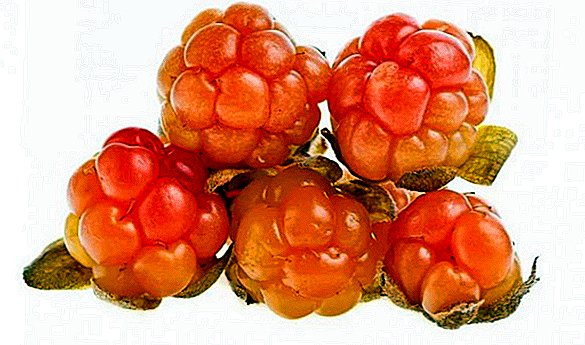 Cloudberry is another member of the Pink family, a perennial shrub or a herbaceous plant about 30 cm high. Thin upright stems end in several leaves. The five-lobed leaves are round. Single white flowers with five petals appear in June-July. The amber-colored cloudberries are shaped like raspberries, but the taste and aroma are different. Ripens in August.
Cloudberry is another member of the Pink family, a perennial shrub or a herbaceous plant about 30 cm high. Thin upright stems end in several leaves. The five-lobed leaves are round. Single white flowers with five petals appear in June-July. The amber-colored cloudberries are shaped like raspberries, but the taste and aroma are different. Ripens in August. 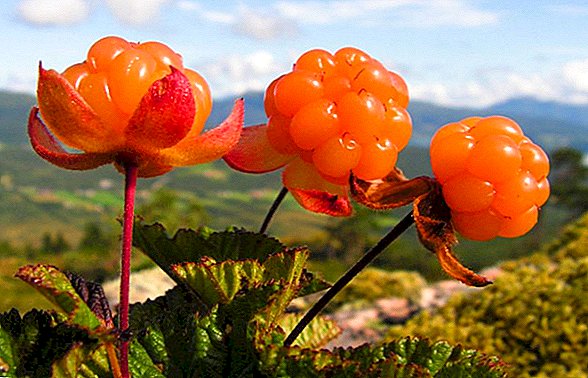 In nature, cloudberries are found in swampy areas in the Northern Hemisphere, the Far East, and Siberia. Industrial production of sweet and healthy berries are engaged in special plantations in the Scandinavian countries and America.
In nature, cloudberries are found in swampy areas in the Northern Hemisphere, the Far East, and Siberia. Industrial production of sweet and healthy berries are engaged in special plantations in the Scandinavian countries and America.
It is quite difficult to grow cloudberries on the plot, it is necessary to create conditions similar to its natural habitat. To do this, you need to dig a ditch with a waterproofing that simulates a swamp, and fill it with a mixture of peat and forest floor and maintain the necessary humidity. It is better to propagate cloudberries vegetatively, it is difficult to grow seeds. 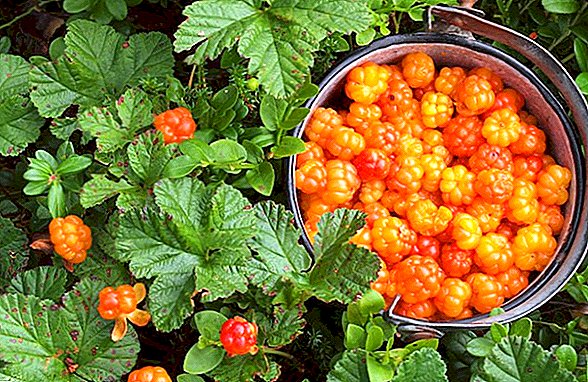 Cloudberries are a source of ascorbic acid, vitamins PP, A, B. The berry contains malic and citric acids, pectins and tannins.
Cloudberries are a source of ascorbic acid, vitamins PP, A, B. The berry contains malic and citric acids, pectins and tannins.
By the amount of vitamin A, cloudberries are several times ahead of carrots, and there is more vitamin C in it than in citrus fruits.
Fruits can be consumed fresh and for making different sweet desserts, jams, drinks. Also, cloudberries are consumed in the wet form.  Cloudberry is used in medicine as an antispasmodic, antimicrobial and diaphoretic. Berry improves the gastrointestinal tract and heart, helps in the treatment of skin diseases.
Cloudberry is used in medicine as an antispasmodic, antimicrobial and diaphoretic. Berry improves the gastrointestinal tract and heart, helps in the treatment of skin diseases.
Cloudberries are contraindicated in yazvennik and people suffering from gastritis with high acidity during the period of exacerbation.
Did you know? In Finland, cloudberry is a national symbol and is depicted on a 2 euro coin.
Gumi
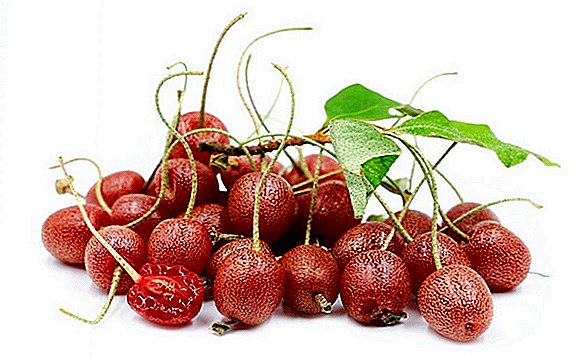 Gumi is a beautiful ornamental shrub with healthy berries originally from East Asia. Belongs to the family Lokhovye, can reach a height of more than 2 m. The leaves are elliptical in shape, smooth, similar to laurel. The flowers are white and fragrant. Bright red fruits oblong or spherical shape with long stalks and seeds inside. Gumi berries are about 2 cm long, look like dogwood, ripen in mid-summer. The taste of berries is sweet and sour, slightly tart, similar to the taste of grapes, cherries and apples.
Gumi is a beautiful ornamental shrub with healthy berries originally from East Asia. Belongs to the family Lokhovye, can reach a height of more than 2 m. The leaves are elliptical in shape, smooth, similar to laurel. The flowers are white and fragrant. Bright red fruits oblong or spherical shape with long stalks and seeds inside. Gumi berries are about 2 cm long, look like dogwood, ripen in mid-summer. The taste of berries is sweet and sour, slightly tart, similar to the taste of grapes, cherries and apples. 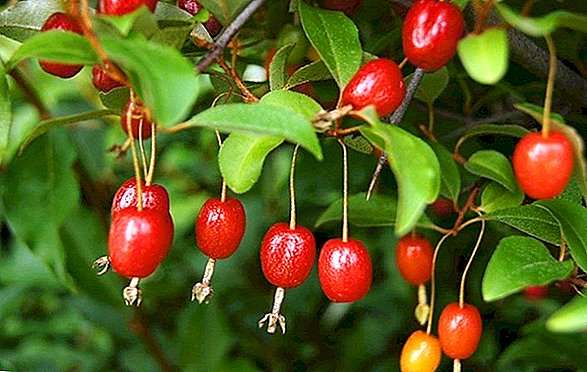 Gumi is home to Japan, China and Korea, also cultivated on Sakhalin. If desired, you can grow gumi in your backyard. The bush loves the sun, fertile soil neutral on acidity. Propagated by layering, cuttings and seeds.
Gumi is home to Japan, China and Korea, also cultivated on Sakhalin. If desired, you can grow gumi in your backyard. The bush loves the sun, fertile soil neutral on acidity. Propagated by layering, cuttings and seeds.
Gumi berries are valued by a rich vitamin composition, especially a lot of vitamin C. They also contain valuable amino acids and metals. Not only berries are useful, but also flowers and leaves. In the east, gumi are used to prolong youth and longevity. They produce a tonic effect on the body, tone up, improve the performance of the gastrointestinal tract, prevent sclerosis and cardiovascular diseases, and have anti-inflammatory properties. Sweet and sour berries are used in cooking for the preparation of various sauces, drinks and vitamin supplements. 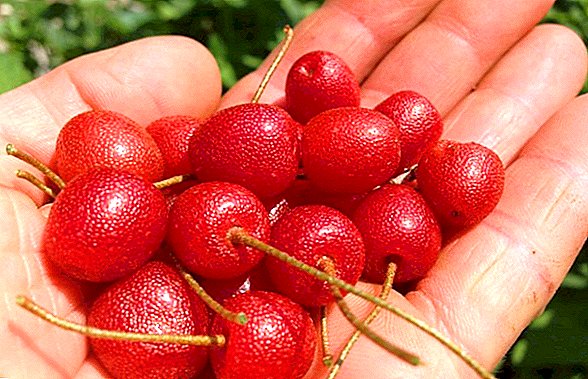 Gumi berries are contraindicated in case of individual sensitivity and in diabetes mellitus.
Gumi berries are contraindicated in case of individual sensitivity and in diabetes mellitus.
So, we learned the main properties of the most popular red berries. Ornamental shrubs are able to decorate the garden and garden, give a wonderful harvest. Anyone can grow healthy berries, provide themselves and their family with a vitamin delicacy, and also use them as medicines.



